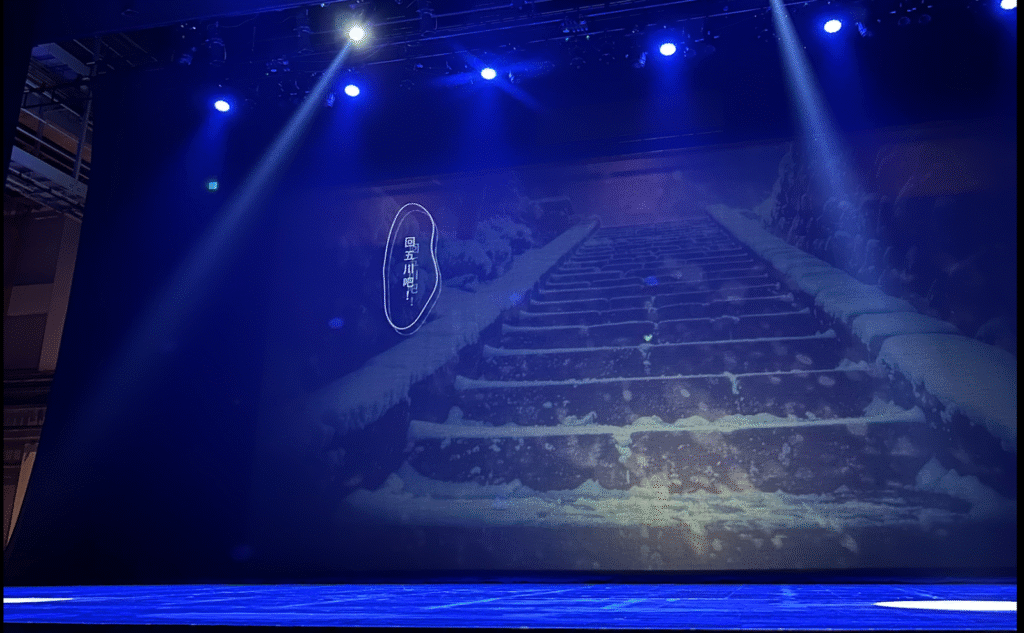Sophia Huang’s groundbreaking integration of dynamic supertitles is redefining accessibility in the performing arts.
In the world of theater, a quiet revolution is unfolding. The curtains rise, and what begins as a traditional stage production quickly becomes something far more immersive. The actors speak, and alongside their performances, a dynamic new form of storytelling emerges: supertitles that move, morph, and mirror the emotions of the characters. This is not merely a tool for translation—it is a creative force reshaping how audiences experience language, culture, and accessibility. Welcome to the 2025 production of Kamata March Finale—Gin’s Departure, a show that marks a pivotal shift in how we think about both technology and theater.
Produced by Sophia Huang, this Japanese masterpiece is not just a performance; it is a bold statement about the future of theater. The groundbreaking supertitle system introduced here goes beyond simple translation. Over 2,000 video sequences, each one a visual embodiment of dialogue and emotion, are projected live, synchronized perfectly with the actors’ performances. The result is a multilayered, immersive experience where language becomes part of the emotional fabric of the story, inviting the audience to engage in a more intimate and impactful way.
The Mission Behind the International Performing Arts Consortium
Sophia Huang’s vision for changing theater began long before the introduction of dynamic supertitles. As the founder of the International Performing Arts Consortium (IPAC), Huang sought to create a platform that celebrates global diversity and accessibility. IPAC, a nonprofit organization, serves as a powerful support system for the international performing arts community. It fosters connections between artists, offers comprehensive production support, and aims to break down barriers in the performing arts world.
“At IPAC, we focus on supporting and amplifying voices from all corners of the globe,” Huang shares. “Whether it’s Shakespeare or contemporary Broadway, or even ancient traditions from Asia, our goal is to integrate and celebrate these diverse forms of theater. But our mission extends beyond showcasing art—it’s about making the theater more accessible and inclusive for everyone.”
From its inception, IPAC has been committed to not only representing diverse artistic traditions but also helping to elevate them by integrating cutting-edge technologies and innovative methods. Huang’s approach always considered how to bring these artistic traditions closer to audiences around the world, particularly those who had previously been underserved or excluded.
Reinventing the Role of Supertitles

For many, supertitles are a necessary feature in theater, providing translations for audiences who do not speak the language of the performance. Yet, they have traditionally remained secondary to the main action, often hovering above or beside the stage in a functional, rather than creative, manner. However, in Huang’s production of Kamata March Finale—Gin’s Departure, supertitles become a primary storytelling tool.
Rather than serving simply as a translation device, the supertitles are an integral part of the production. Through an innovative system developed in partnership with Ariel Imaginarium, every line of dialogue is visually reflected by over 2,000 video projections. These projections are not static—they change in real-time to mirror the emotional shifts of the dialogue. When a character speaks with anger, the words flash in bold, jagged fonts; when the mood is tender, the text moves gently, almost like a whisper across the stage.
“Instead of just being a tool for translating words, we wanted the supertitles to be a dynamic part of the performance,” Huang explains. “Each line of text reflects not just the literal meaning but the emotion and the character’s internal journey. The supertitles become as much a part of the performance as the actors themselves.”
This approach to supertitles represents a true breakthrough in the use of technology in theater. The audience doesn’t just read the dialogue—they feel it, as the text projects and shifts with the intensity of the performance. The experience is not just about hearing words, but about engaging with them on a deeper, more emotional level.
Transforming Accessibility in Theater
While the integration of dynamic supertitles is an artistic breakthrough, it also serves a critical function in expanding accessibility for a broader audience. Traditionally, accessibility in theater has been about providing accommodations—such as captioning or sign language interpretation—for those with disabilities. But Huang and IPAC have taken a different approach: accessibility is not just an add-on; it is woven into the very fabric of the performance.
The dynamic supertitles used in Kamata March Finale—Gin’s Departure do more than help those who are deaf or hard of hearing. They also engage audiences who may have difficulty reading subtitles due to dyslexia or language barriers. For audiences who speak different languages or have limited proficiency in the performance’s original language, the supertitles offer a more nuanced, visually engaging experience. The emotional resonance created by the dynamic text allows the performance to transcend language and cultural boundaries, making it accessible to a far wider range of people.
“We wanted to make sure that everyone—regardless of their background, language, or abilities—could engage with the performance in a meaningful way,” says Huang. “Accessibility should never be an afterthought. In this production, it is an essential part of the artistic vision.”
The Future of Theater: An Evolving Landscape
The innovation introduced by Kamata March Finale—Gin’s Departure is not just about a single production—it represents a larger shift in how we think about theater in the 21st century. Huang’s work demonstrates that technology can deepen the emotional impact of a performance, expand accessibility, and elevate the art form to new heights. This integration of visual, emotional, and linguistic elements presents a vision for the future where the boundaries of traditional theater are stretched, and new possibilities emerge.
“Technology can be a tool that enhances the story, not a distraction from it,” Huang asserts. “What we’re doing with dynamic supertitles is showing how digital innovation can coexist with traditional theater and make it more powerful and inclusive.”
As Huang continues to push the boundaries of what is possible in the performing arts, IPAC remains at the forefront of this movement. Through collaborations with international artists and production teams, and a continued focus on accessibility and diversity, the organization is laying the groundwork for a future where theater is truly global and accessible to all.
Join the Movement: Experience the Future of Theater
If you are eager to witness the future of theater unfold, visit the Ariel Imaginarium and International Performing Arts Consortium’s website to learn more about their groundbreaking work. Whether you are an artist, a theater enthusiast, or someone passionate about accessibility in the arts, Ariel Imaginarium and IPAC’s work is reshaping how we experience live performances.
Discover more at IPAC’s official site.
Explore Ariel Imaginarium’s role in transforming performing arts at Ariel Imaginarium’s website.
Stay connected and follow IPAC on Facebook at @SophiaHuangIPAC.


